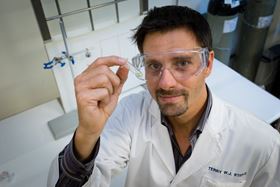 Terry Steele with a sample of Voltaglue. Image: NTU Singapore.
Terry Steele with a sample of Voltaglue. Image: NTU Singapore.Scientists from Nanyang Technological University, Singapore (NTU Singapore), have invented a glue that hardens when a voltage is applied to it, allowing it to be used in wet and damp conditions. A paper on this innovative research was recently published in Nature Communications.
The new adhesive, nicknamed ‘Voltaglue’, opens up a host of possible practical applications, from making underwater repairs to ships and pipes to being a versatile tool for surgery. In future, surgeons could use biocompatible glue patches to join two pieces of internal body tissue together in one or two minutes, compared with the 15 to 20 minutes of careful stitching required for sutures.
Assistant professor Terry Steele, the lead scientist for this research project from NTU’s School of Materials Science and Engineering, said it took them over a year to develop an adhesive that could work under wet conditions such as in the human body or underwater. “Most glues in the market don’t work under wet conditions, much like how sticky tapes won’t work if the surface is wet, since the adhesive will stick to the water instead of the surface,” he explained.
Usually, adhesives such as superglue harden upon contact with moisture in the air. Others like epoxy, which is often used in electronic mobile devices, has to be baked at high temperatures of about 150°C, or made by mixing together two different chemicals. These methods are unsuitable in wet environments.
“We had to find a way to make glue which cures (hardens) when we want it without being affected by the environmental conditions, so electricity was the best approach for us,” said Steele. “The hardness of our glue can be adjusted by the amount of time we apply a voltage to it, which we call electrocuring.”
This unique electrocuring property allows Voltaglue to be customised for different applications. “For example, if we are gluing metal panels underwater, we want it hard enough to stick for a long time. However, for medical applications, we want the glue to be more rubber-like so it wouldn’t cause any damage to the surrounding soft tissues.”
Voltaglue is developed using hydrogels consisting of carbon molecules called carbenes grafted onto tree-shaped molecules known as dendrimers. Upon contact with electricity, the reactive carbenes, which are capable of hooking onto any surface nearby, are released. The number of ‘hooks’ released depends on how long electricity is applied and how many carbenes are present.
Another distinct feature of the new glue is that it could be made reversible, offering the possibility of producing products that can be easily recycled, reused or remanufactured into new parts and components so as to reduce waste and energy consumption. For example, it would allow automakers and shipyards to assemble and dissemble parts with ease, minimizing the need for fixation by bolts, nuts and screws.
Moving forward, Steele and his team of 11 researchers are working to improve their new electrocuring glue so it can harden in just a few seconds, compared to about 30 seconds at the moment. The Voltaglue technology is currently patented through NTUitive, the university’s commercialisation arm, and Steele and his team are also looking for the best way to commercialize it through a new start-up or via industry partnerships.
This story is adapted from material from NTU Singapore, with editorial changes made by Materials Today. The views expressed in this article do not necessarily represent those of Elsevier. Link to original source.